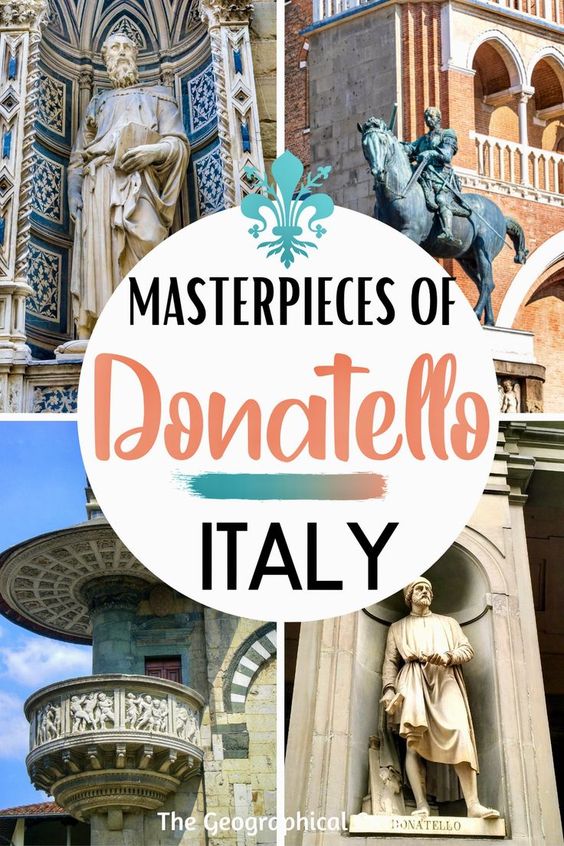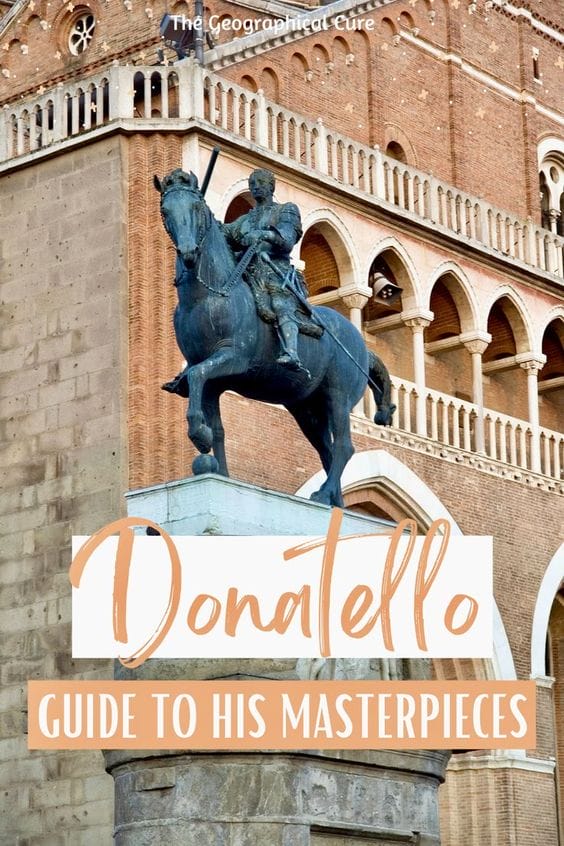Here’s a guide to the most famous masterpieces of Donatello, one of the founding fathers of the Renaissance. These art works are mainly located in Florence, Italy.
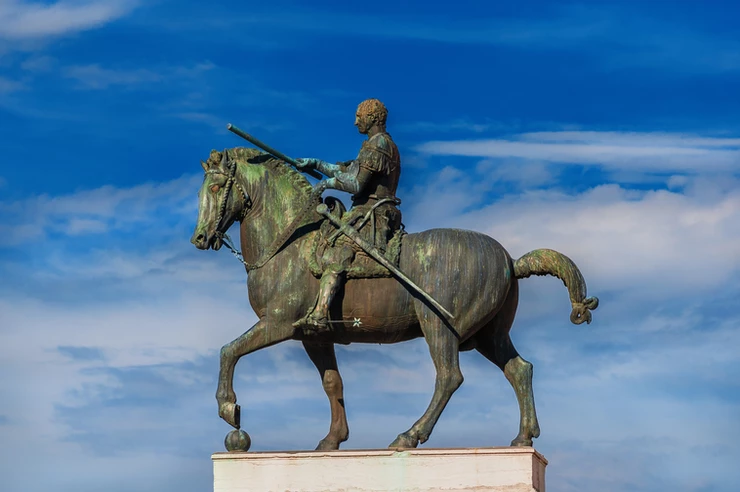
Donatello, born Donato di Nicolo di Betto Bardi, was the most influential and innovative sculptor of the 15th century. He essentially invented Renaissance sculpture and had a profound effect on Michelangelo and later generations of Renaissance artists.
Donatello moved away from Gothic depictions and re-introduced elements from classical Greco-Roman sculpture, which he had studied in Rome.
He departed from the prevailing flat iconography and sought to depict the human experience, producing natural and highly emotional works. With Donatello, life seems to burst out of marble and bronze.
Donatello can’t be locked into a formula. He had a tremendous range of expression, with a prolific creative energy.
He worked in many mediums, including bronze, wood, marble, stucco, and terracotta. According to Giorgio Vasari, his works were “full of grace and excellent” with a “fine sense of design.”
Short Biography of Donatello
Donatello was born in 1386 in Florence. His father was in the wool guild, so he was placed on the path of trade. Donatello was educated by the wealthy Martelli family. They were bankers, art patrons, and friends of the Medici.
READ: History of the Medici
In 1403, Donatello became an apprentice of the Florentine metalsmith and sculptor Lorenzo Ghiberti. Donatello assisted Ghiberti when he won the competition for the north doors of the Florence Baptistery. (The original doors are now in the Duomo Museum in Florence.)
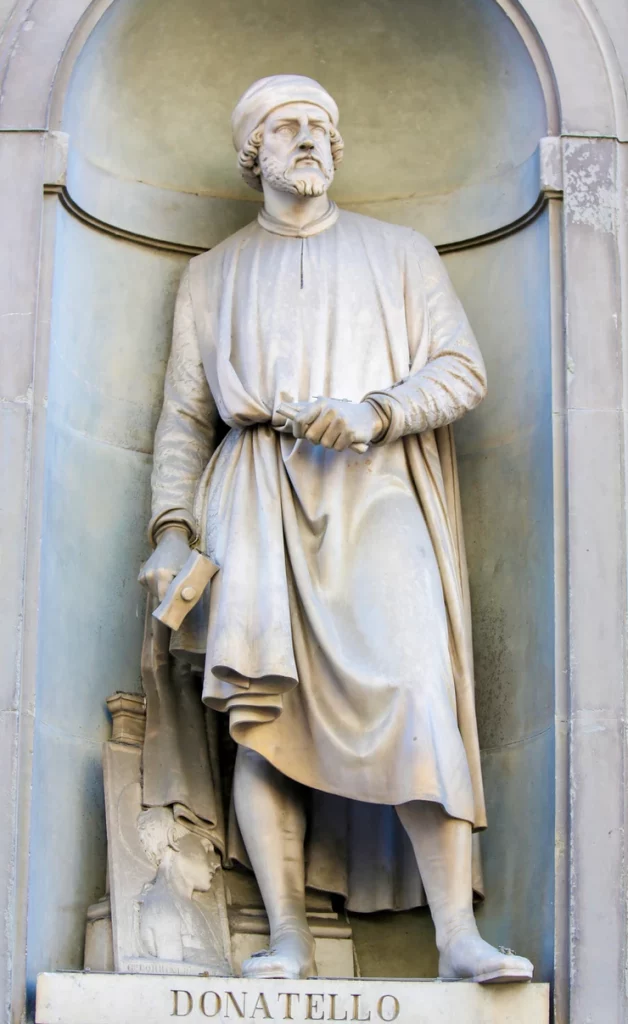
Some art historians report that Donatello was friends with the architect Filippo Brunelleschi. Around 1407, they traveled to Rome and excavated ruins, searching for knowledge about classical Rome.
After that sojourn, for the next two decades, Donatello developed his own distinctive style, one which elevated emotion and drama to the forefront. He moved away from the Gothic technique and adopted a classical technique emphasizing realism. His sculptures show immense personality in their facial expressions and attire.
Donatello had a close (and lucrative) relationship with Cosimo de’ Medici during his years in Florence. It was Cosimo’s commission that produced Donatello’s greatest work, the Bronze David. Cosimo’s lasting patronage allowed Donatello to experiment with his style. It brought him fame and financial success in his lifetime.
In the 1440s, Donatello moved to Padua. There, he created the first equestrian statue since Ancient Rome and created a great altar for the Basilica of St. Anthony. But there is a record of Donatello falling ill in Padua.
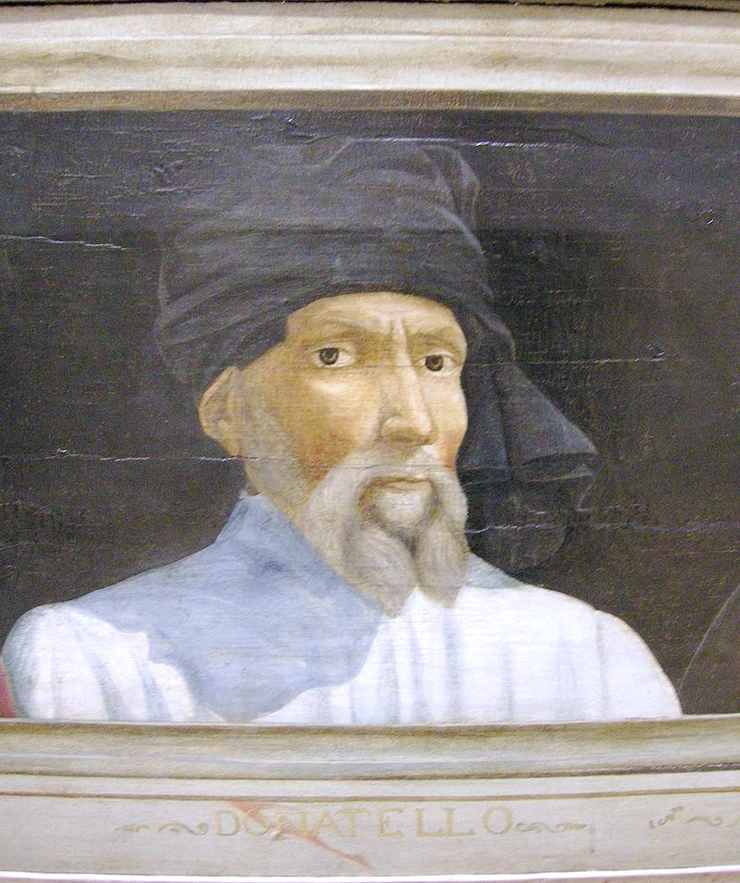
In 1455, Donatello returned to Florence, working on a big commission for the Basilica of San Lorenzo. His work changed, suggesting he recognized his own mortality. He died in 1466. He was buried in San Lorenzo next to Cosimo.
Though much is known about Donatello’s career, there are only murky details of his personal life. We know that Donatello never married and had no children. Possibly, he was gay. Though that theory is based solely on contemporaneous anecdotal rumors.
Donatello was reputedly a difficult man to deal with. He could be prickly and abrasive to patrons and others. That passion carried over to his work. Donatello was known to mutter “speak, damn you, speak!” at his figures as he worked.
In an era when artists were regulated by guild rules, Donatello demanded a level of artistic freedom. He once destroyed a sculpture rather than give it to a critical patron, who Donatello thought devalued his work. Donatello likely only got away with this bad behavior because of Cosimo’s patronage.
Giorgio Vasari also recounts that Donatello was agnostic. This may account for his unusual takes on biblical subjects.
READ: Guide To the Works of Giorgio Vasari
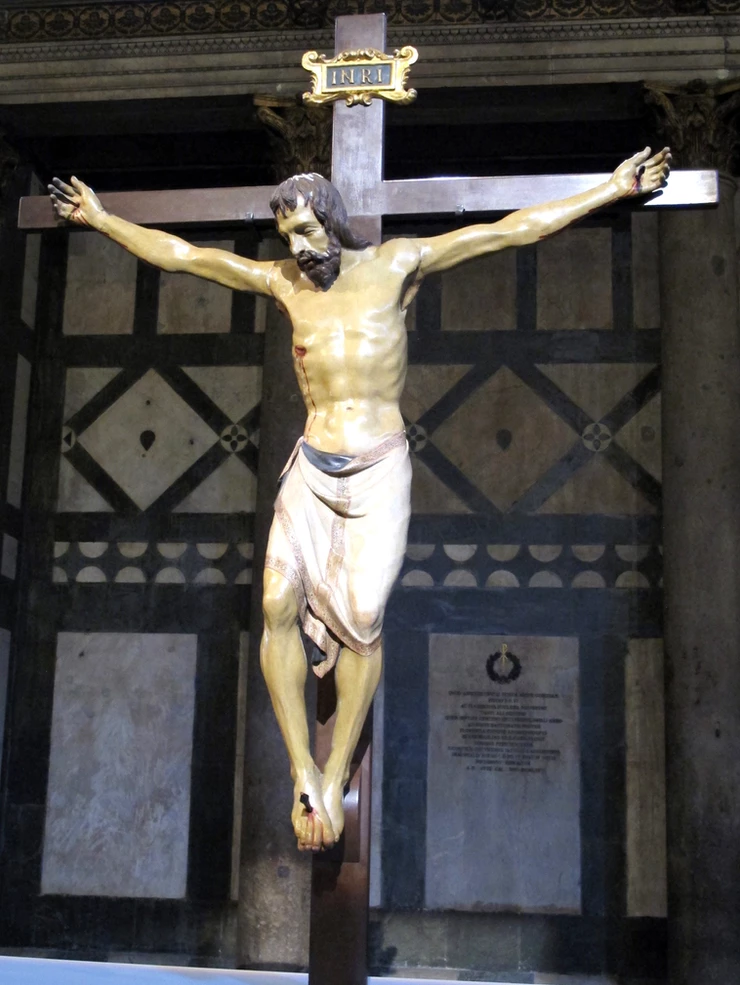
20 Most Famous Masterpieces of Donatello
Let’s take a tour of Donatello’s most famous masterpieces and art works, in chronological order. Most of Donatello’s works are in Florence. But there are also some in Siena and Padua.
1. Crucifix, 1406-08 | Basilica of Santa Croce, Florence
Santa Croce’s painted wooden crucifix is one of Donatello’s early works. Christ is bearded, tanned, muscular, and sorrowful.
The sculpture is a far cry from the usual idealized or heroic depictions. Christ’s face looks broken and swollen. His eyes are half closed. Brunelleschi, a close friend of Donatello, accused the sculptor of “crucifying a peasant.”
Legend holds that, in response to Brunelleschi’s criticism, Donatello told him to go sculpt his own crucifixion. So Brunelleschi proceeded to sculpt one in secret.
According to Giorgio Vasari, one day when Donatello was entering Brunelleschi’s house, he saw Brunelleschi’s version. He was so impressed that he dropped the eggs he was carrying in admiration.
The crucifixion attributed to Brunelleschi is in the Gondi Chapel of the Basilica of Santa Maria Novella.
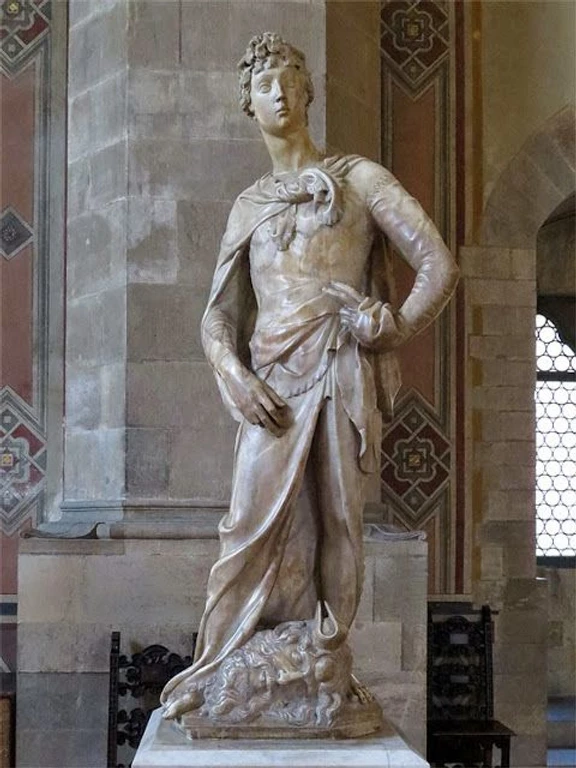
2. Marble David, 1408-09 | Bargello Museum, Florence
Marble David is an early work by Donatello, completed 30 years before his famous Bronze David. (And you can tell.) It was commissioned to be a statue on a buttress of Florence Cathedral. But it wasn’t large enough. It was placed outside the Duomo for 7 years.
Then, the City Council basically stole it and placed it in the Piazza della Signoria. Marble David then traveled from the Palazzo Vecchio to the Uffizi Gallery and, finally, to the Bargello Museum. The Bargello is Florence’s sculpture museum.
Donatello was only 22 when he carved Marble David. He was still rooted in the International Gothic Style. David’s face is expressionless and largely lifeless. The pose is static. Marble David doesn’t seem terribly beautiful at first glance, probably because it was intended for a high perch.
Dontatello worked twice on the statue. When it was moved to the Piazza della Signoria, he was asked to transform, to the extent he could, Marble David from a spiritual figure to more of a Renaissance action figure.
Donatello added a bronze sling and attempted to hide David’s scroll in drapery. The sculpture represents an important moment in art history — the transition from Gothic to Renaissance classicism.
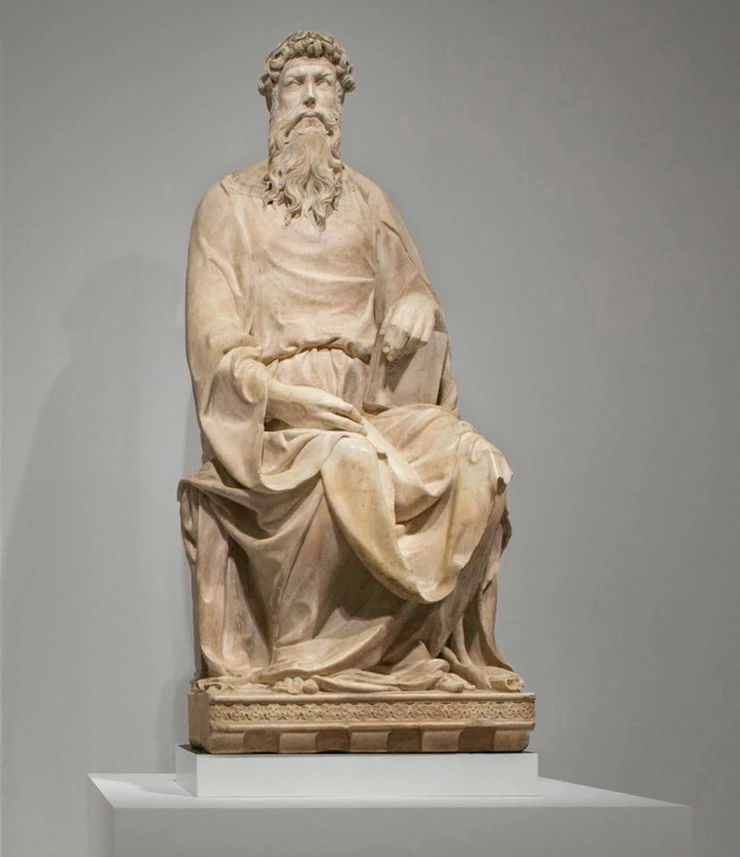
3. St. John the Evangelist, 1408-15 | Duomo Museum, Florence
St. John is a large scale figurative marble sculpture. It was to be placed, together with other Evangelists sculptures, on the facade of Florence Cathedral.
In 1587, St. John and the other sculptures, was removed from the facade and placed inside the Cathedral. In 1930, they were moved into the Duomo Museum.
This statue almost seems to anticipate the works of Michelangelo, particularly Michelangelo’s fierce Moses. See for example the saint’s acute and penetrating expression, and the realistic treatment of his open hand on the book.
St. John was typically depicted as a young man. But Donatello instead portrays him as an aging prophet, in a more humanizing rendition.
The top half of the sculpture is idealized. But the legs and hands are rendered more realistically. Donatello pays attention to the anatomy of the saint’s legs, even though they are hidden under his robes.
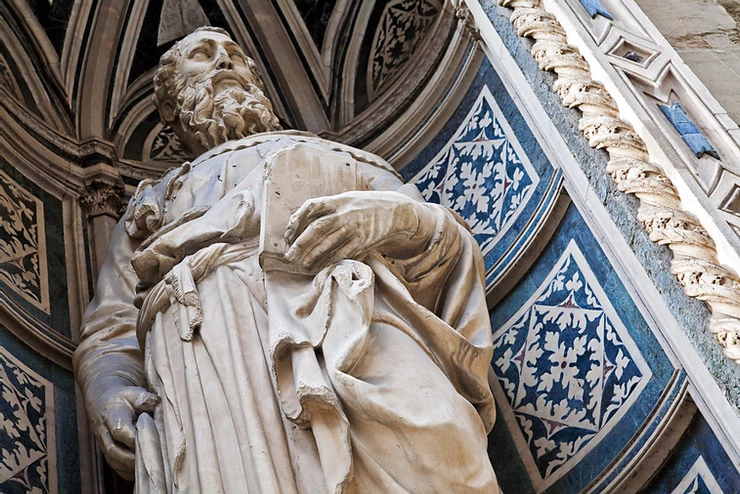
4. St. Mark, 1411-13 | Orsanmichele, Florence
Orsanmichele’s most famous sculpture is Donatello’s St. Mark. The statue of St. Mark was commissioned by Florence’s linen guild, one of the poorer guilds. The larger than life statue stands almost 8 feet high.
It’s the first truly Renaissance piece of art (sculpture was more advanced than painting). Donatello revived the use of the contrapposto stance in freestanding sculpture, giving St. Mark a more natural, less stylized, pose.
St. Mark marked a revival of classical themes and naturalism. St. Mark was even given a receding hairline. The drapery covering his body falls over him, echoing the body’s form. Prominent veins appear on Saint Mark’s hand as it clutches a gospel.
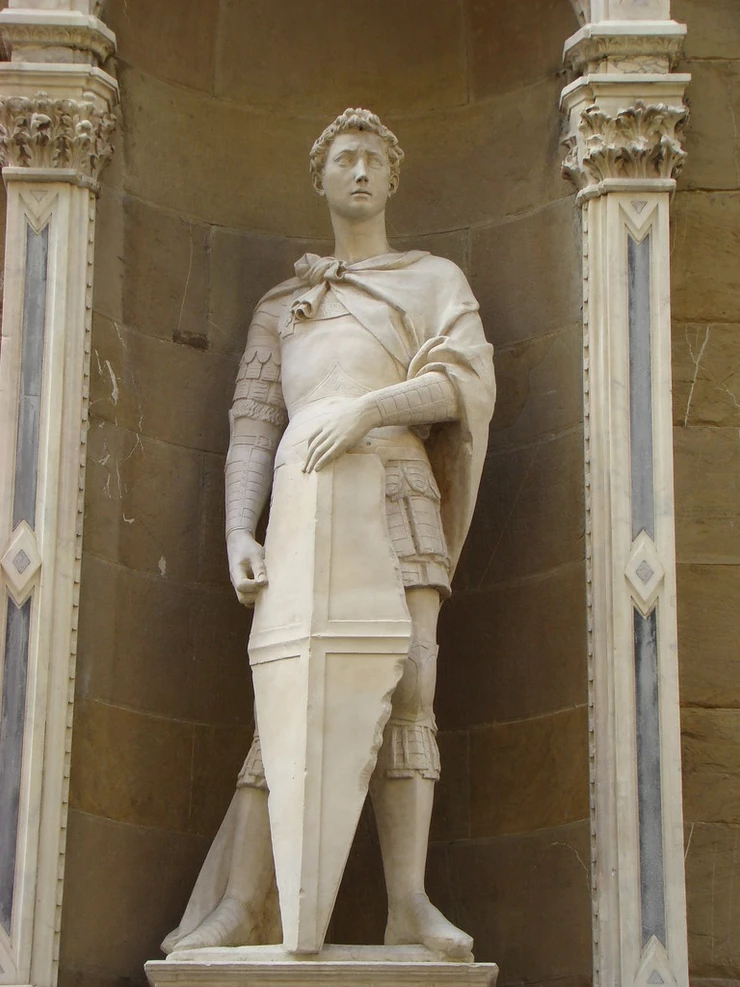
5. St. George and the Dragon, 1416 | Bargello Museum, Florence
St. George is one of Donatello’s best works. Like St. Mark, it was originally on the facade of Orsanmichele. To protect it, the sculpture was moved to the Bargello Museum in 1892 and placed in a duplicate marble niche.
The sculpture is based on the legend of St. George and the dragon, a familiar fairytale. A town is besieged and attacked by a plague bearing dragon. Desperate, the town offers sheep to keep the dragon away.
When it runs out of sheep, the town offers a person once a year, selected by lottery.
When the town princess is chosen, there’s panic. But St. George steps in, slays the dragon, and marries the princess.

Commissioned by the shield makers guild, the sculpture shows St. George with a large diamond shaped shield. Wearing Roman armor, he appears as if he might jump out of the niche.
He once clutched a sword, which is now gone. If you replace the sword with a stone in your mind, it conjures visions of Michelangelo’s David, to come a century later.
Below the sculptures is a low relief panel. It continues the story, showing St. George slaying the dragon and rescuing the princess. The panel is considered the first example of a technique called rilievo schiacchiato, or “squashed” relief, which Donatello pioneered.
The technique is intended to give the illusion of deep space on a relatively flat surface. Leonardo da Vince studied Donatello’s relief. Unfortunately, because the statue was outside for five centuries, much of the detail has been eroded.
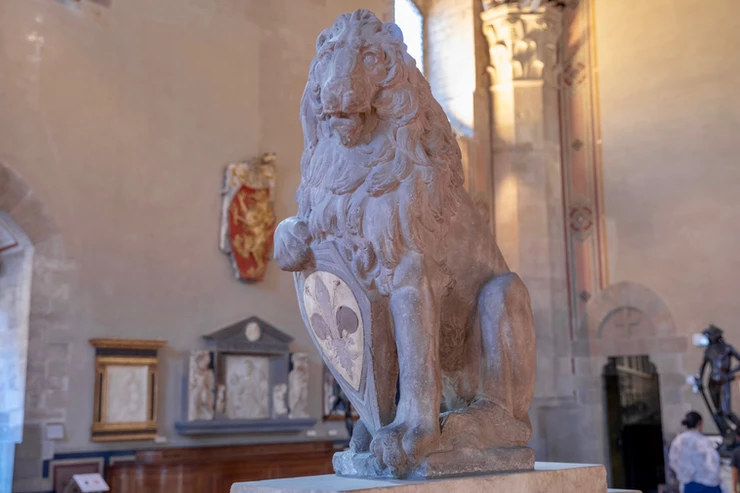
6. Marzocco, 1416 | Bargello Museum, Florence
Marzocco was the first statue the Medici placed in the Piazza della Signoria. The word “Marzocco” comes from the Latin word Marte, referring to Mars, the god of war.
The statue was intentionally symbolic. A heraldic lion, carved from gray sandstone, sets his paw on a shield with a red fleur de lis on a white background.
That’s Florence’s flag and it was a symbol of the civic militia. Though it was a powerful economic center, Florence wasn’t a military power and didn’t have a standing army.
The city viewed itself as an underdog in all the regional skirmishes. If Florence was in trouble, the Council sounded a gong. The citizens — the civil militia — came forward with their swords and weapons to defend the city.
Marzocco appears humanized. Michelangelo reputedly said that Marzocco was the most “honest man” he knew. In 1885, Marzocco was moved to the Bargello for preservation. A copy is now in the Piazza della Signoria.
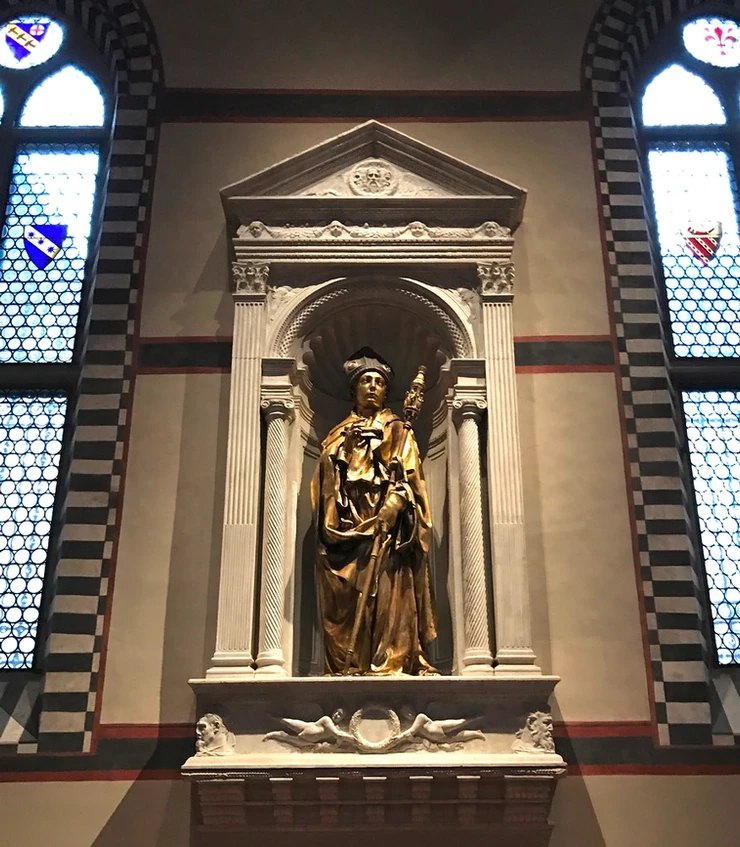
7. St. Louis of Toulouse, 1423-25 | Museum of the Basilica of Santa Croce, Florence
St. Louis of Toulouse is Donatello’s earliest surviving bronze sculpture. Donatello tells the story of the humble friar who abdicated his throne for the church.
Louis wears the sandals of a Franciscan friar. St. Louis’s gesture of blessing and the drapery of his attire show a classical influence. This sculpture was originally installed in a niche on the facade of Orsanmichele. Then, it was moved to the Santa Croce Museum.
Initially, the sculptures was criticized. With its dark patina, it may have been harmonized better with the marble of Orsanmichele than the plaster of the museum.
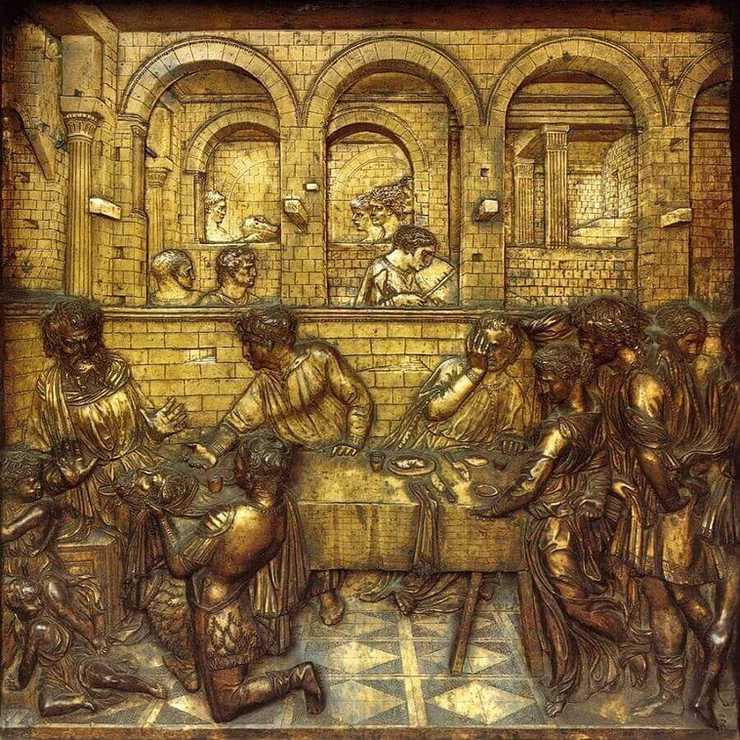
8. Feast of Herod, 1422-27 | Baptistery of Siena Cathedral, Siena
In 1427, Donatello produced his first bas relief for the baptismal font of Siena Cathedral, the Feast of Herod. The bronze relief was renowned for its pioneering single point perspective. Donatello was inspired by Filippo Brunelleschi’s experiments with linear perspective.
Rather than focusing on one single vanishing point, Donatello used a V as a vanishing point, to help draw the viewer’s eye across the scene. Donatello also uses a combination of high relief and low relief to convey a convincing illusion of space and depth.
The relief is based on the famous bible story. Pleased by his daughter-in-law Salome’s dancing, Herod says he will grant her any wish. She asks for the head of John the Baptist. Herod begrudgingly accedes to her request.
Donatello’s relief depicts the moment when the decapitated head of John the Baptist is presented to Herod on a platter. Donatello portrays John’s martyrdom without explicitly showing the gory details of the beheading, which were present in previous renderings.
Herod and his companions physically recoil from the graphicness of the severed head. The viewer thus is drawn into the scene because of the emotions on display.
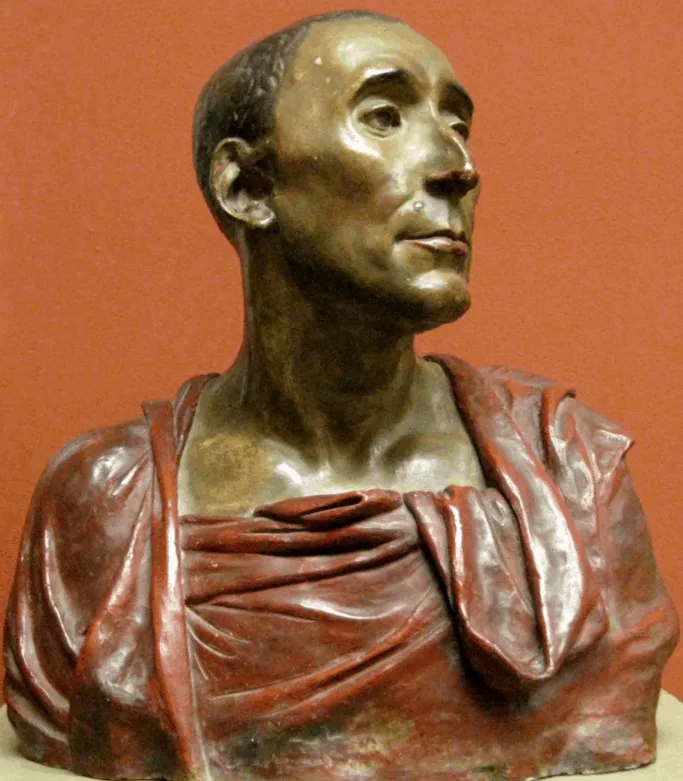
9. Bust of Niccolo da Uzzano, 1432 | Bargello Museum, Florence
Donatello was gifted enough to work in any material to create his sculptures. One of his most sculptures is a half bust of a man named Niccolo da Uzzano. It was created with polychrome terracotta. It’s one of the oldest of its kind from the Florentine Renaissance.
Da Uzzano was a famous politician in Florence. The sculpture was created one year after his death. It offers a very realistic view of his appearance.
He appears proud and moralistically superior. His head is tilted sideways and the eyes are cast to the side. The subtle movement makes the bust seem like a real person, not just a still life.
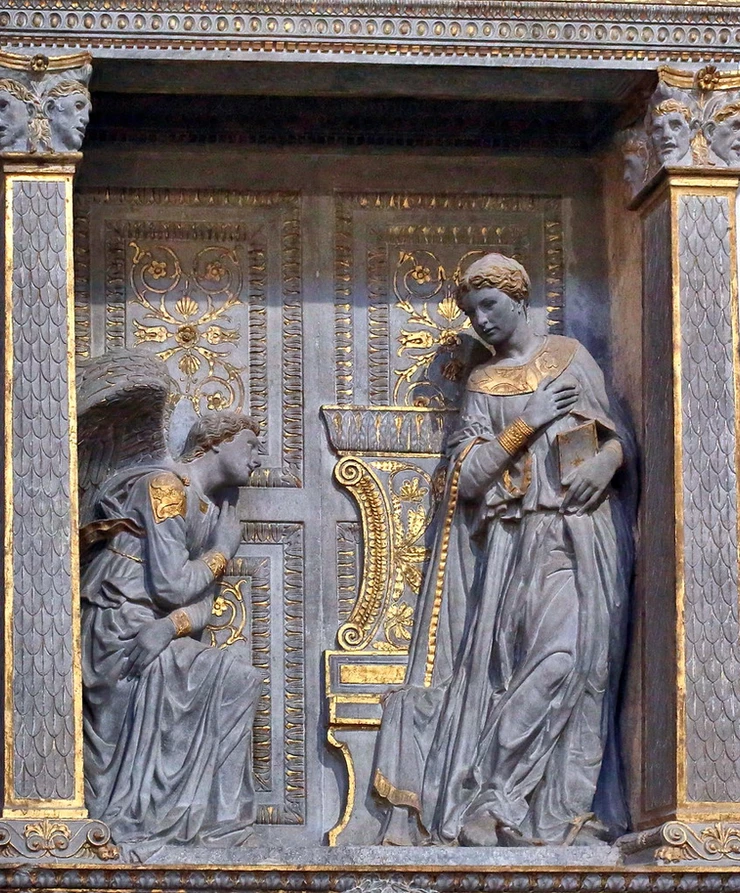
10. The Annunciation Tabernacle, 1435 | Basilica of Santa Croce, Florence
This magnificent Donatello high relief sculpture sits casually on a church wall near the Cavalcanti Chapel in the Basilica of Santa Croce. It’s a massive piece, 7 feet by 5.5 feet. The Annunciation — the moment Mary learns that she will bear Christ — is one of the most common Renaissance themes.
The sculpture is lavishly gilded. Donatello departs from prior depictions of the Annunciation with strong realism and a psychological narrative.
Mary isn’t portrayed as divine, but as a woman startled by the kneeling angel Gabriel. Gracefully, a fearful Mary turns to him as he greets her.
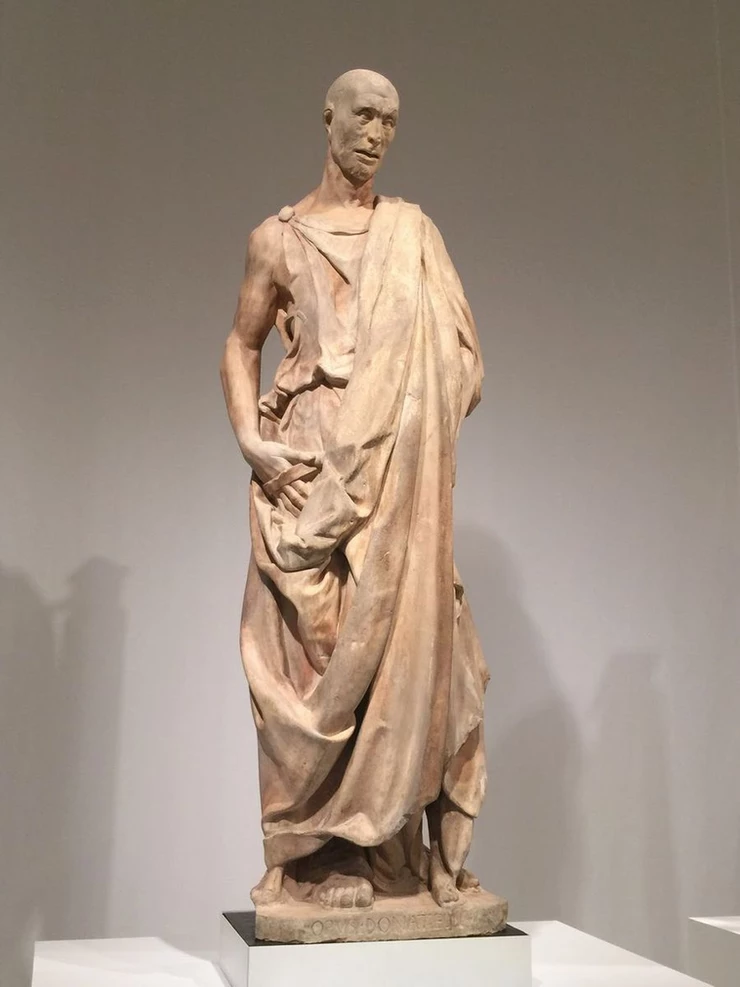
11. Habakkuk, 1423-26 | Duomo Museum, Florence
Between 1415-35, Donatello created five statues for the campanile or bell tower of the Florence Cathedral. Now they’re in the Duomo Museum. The most famous is Habakkuk.
Habakkuk was an Old Testament prophet. Donatello’s statue is nicknamed Zucoone, which translates to big pumpkin head.
Legend holds that this was Donatello’s favorite of his sculptures. He would allegedly punctuate oaths with the phrase “By the Zuccone.”
Habakkuk stands in contrapposto, with a toga draped over his body. He looks quite bald, but there are a few strands of hair. He seems a combination of wild man and Roman orator.
The most arresting part of the statue is the prophet’s intense face. You can easily imagine him as a fire and brimstone preacher of doomsday.
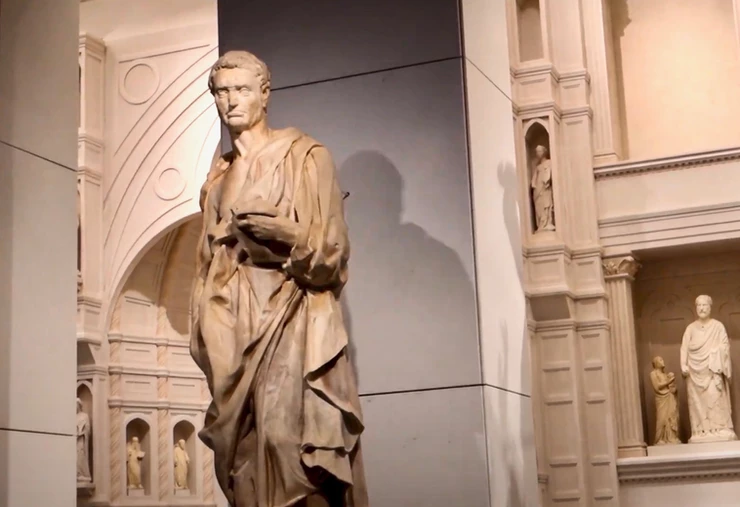
12. Jeremiah, 1427-35 | Duomo Museum, Florence
Donatello’s Jeremiah stands right next to Habakkuk in the Duomo Museum. In contrast to Habakkuk, Jeremiah was a reluctant prophet.
He’s portrayed glowering, with lips clamped shut. His Roman toga is folded over his mid section, which was said to have the word of god burning within.
Unlike Habakkuk, he looks uncertain and fatigued. His right hand is awkward. You get a real sense of his personality, which was Donatello’s special gift.
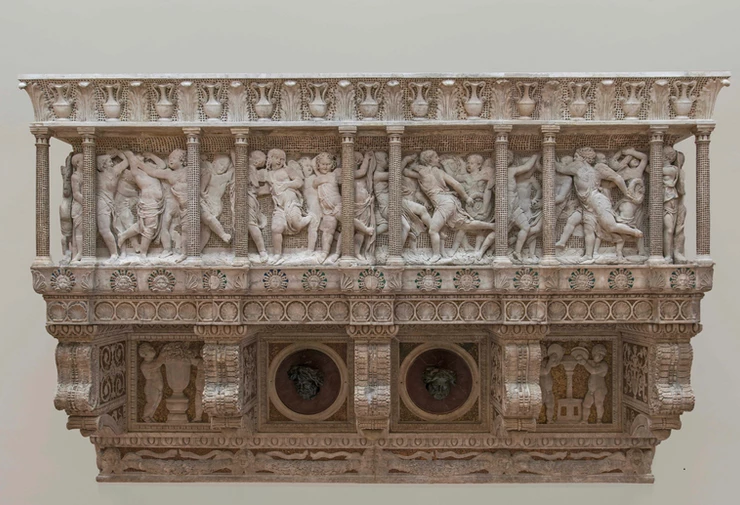
13. Choir Loft, 1431-39 | Duomo Museum, Florence
Between 1431-389, Donatello and Luca della Robbia carved Cantoria for the Duomo’s sacristy doors. At first glance, they look like rather large sarcophagi. The choir lofts were removed from the Duomo in 1688 and put into storage. They were reassembled in the Duomo Museum.
The lofts are called “cantoria,”which translates into either singing loft, choir loft, or organ loft. Given the ambiguous translation, it’s unclear exactly what they used for, other than the production of music.
They’re set at their original height in an arched hallway called the Sala della Cantorie. The lofts are arranged face to face, giving you a chance to compare and contrast the styles of two early Renaissance masters. There’s wasn’t an official competition, but Donatello wins the virtual one.
In Donatello’s loft, the artist pulls out all the decorative stops — mosaics, enamel, gold, relief, motifs. One frieze is decorated with a motif of cherub heads set into enamel. There’s also gold mosaic decoration behind the dancing low relief cherubs, who run and jump wildly.
In the two central panels, there are two bronze busts. No one knows who they are. One is theorized to be an ancient Roman bust. At the top, is a running frieze with amphora and acanthus.
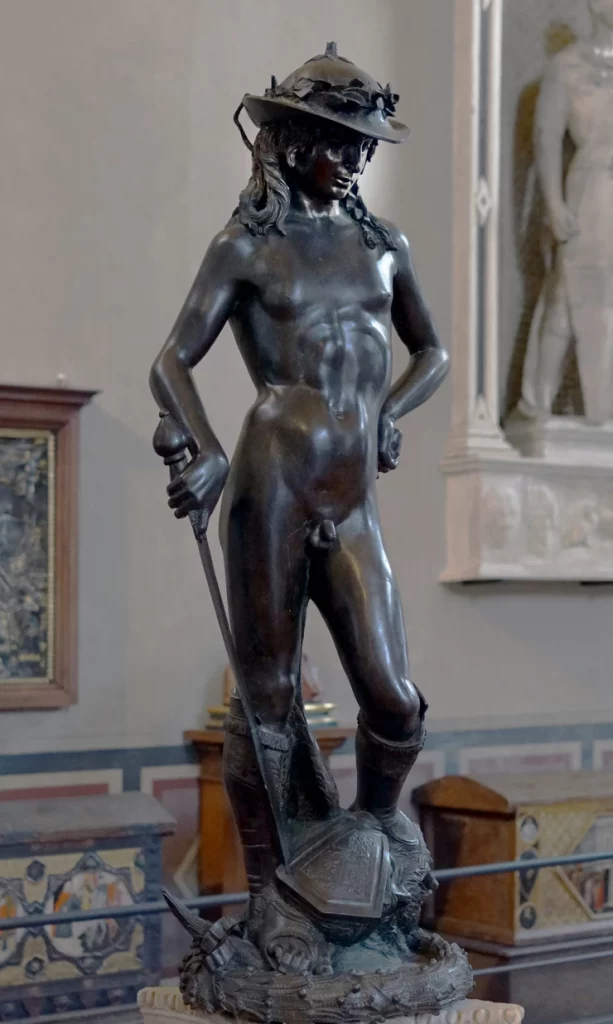
14. Bronze David, 1440s | Bargello Museum, Florence
Commissioned by Cosimo de’ Medici, the beautiful Bronze David is Donatello’s greatest masterpiece. Bronze David is the first freestanding nude sculpture since Greco-Roman times.
It was a radical depiction of the biblical story of David and Goliath. David became a mascot of sort for Florence, as an underdog city state.
A life-like Bronze David elegantly reinterprets the classical canon. The statue inspired Michelangelo to carve his own David (in the Galleria dell’Accademia) in the nude.
But it’s not a heroic rendering. There’s nothing modest about Bronze David. It’s simultaneously eroticized and androgynized. The piece was created for a private environment, where it would be acceptably cheeky.
A pre-pubescent and long haired David stands enigmatically, in a relaxed contrapposto stance with one foot on Goliath’s head. He’s peculiarly depicted wearing no clothes except for a hat and boots, perhaps to suggest his underdog status. The statue is affectionately nicknamed “Puss ‘N Boots.”
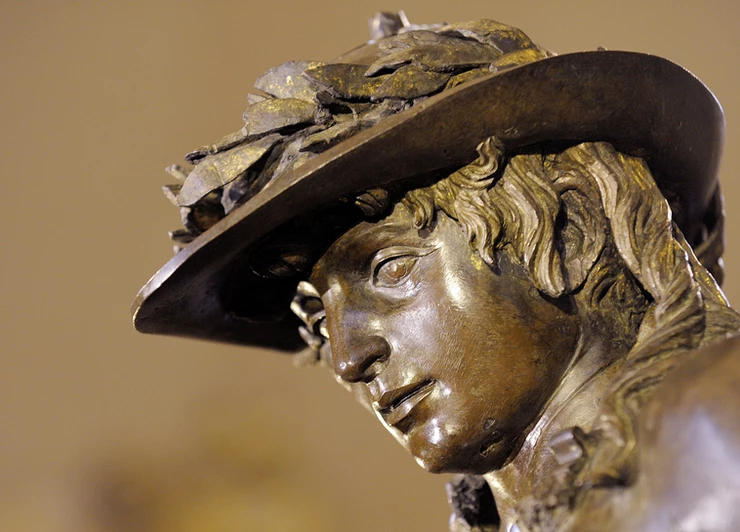
The nudity of Bronze David is biblically accurate. But Donatello’s Bronze David has a girlish figure.
A feather climbs up his right leg, a symbol associated with homosexuality. Based on ancient busts, some art historians believe that Bronze David was modeled after the Roman Emperor Hadrian’s gay lover, Antinous.
READ: Guide To Hadrian’s Villa in Tivoli
In fact, at that time, Florence was a bit of a gay mecca. Homosexuality between unmarried men was common, but illegal. During a crack down, even Leonardo da Vinci was arrested. Donatello himself was reputedly gay, with a habit of falling hard for his male models.
When the Medici were exiled, Bronze David was requisitioned by the Signoria (Council of Florence) and placed in the garden courtyard of the Palazzo Vecchio. In 1495, it was moved to the Piazza della Signoria, which served as Florence’s outdoor sculpture gallery.
Bronze David was damage by lightening in 1511, and is missing a few pieces. It’s been restored and laser cleaned. The restoration revealed traces of gilding (gold leaf) on the boy’s helmet, hair, and boots. The sculpture may initially have presented with gold hair.
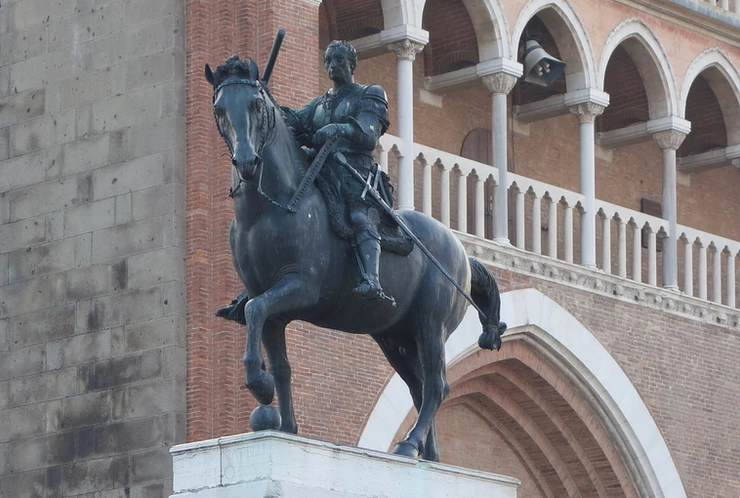
15. Gattamelata, 1453 | Padua
Gattamelata is an extraordinary sculpture. It was the first great equestrian statue since ancient Rome, 1000 years earlier.
In 1443, Donatello was hired by the heirs of Erasmo da Nardi, whose nickname was Gattamelata. Gattamelata was a famous mercenary in the service of the Republic of Venice. The nickname translates into “honey cat,” not exactly a terrifying nickname for a mercenary general.
READ: Nutshell History of Venice
Gattamelata stands in the Piazza del Santo in front of one of Italy’s most beautiful and important churches, the Basilica of St. Anthony in Padua. The basilica houses the body of St. Anthony of Padua (including his tongue and vocal cords), making it a popular pilgrimage locale.
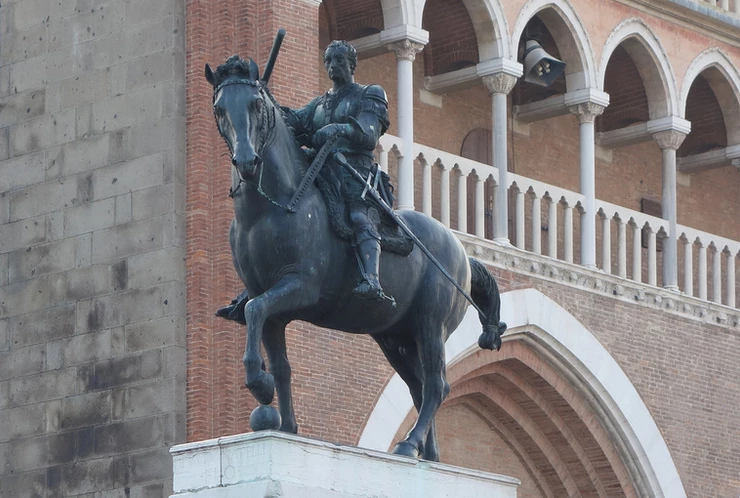
By this time, Donatello was at the height of his powers, having already created the Bronze David. He created a majestic statue elevated so high, on a 26 foot pedestal, that you can’t see it that well in person. It’s difficult to find a vantage point to really absorb it.
Donatello renders the horse in a very naturalistic style, with anatomical accuracy. The left front hoof is raised, giving it a dynamism. It rests on an orb, a cannonball, which represented the power of the Venetian army and served as a mechanical support for the statue.
Gattamelata is outfitted in full military regalia, with his long sword at his side. With his right hand, he holds a baton. He has a serious pensive look on his face, underscoring the seriousness of his profession. There’s a decoration on the base of the pedestal.
Gattamelata became a hallmark or prototype for the return of equestrian sculpture in Italy and Europe. It was so popular that other nobles clamored for a similar depiction.
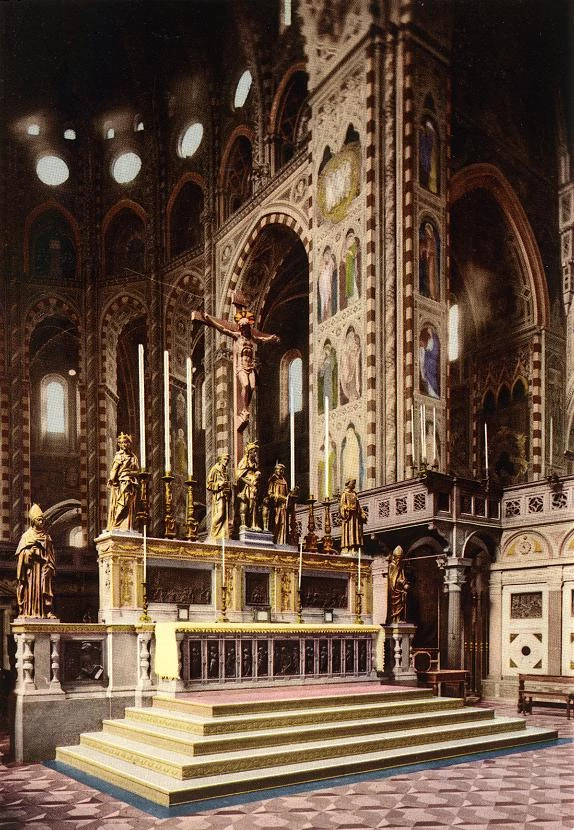
16. Statues on the Altar of the Basilica of St. Anthony, 1447-50 | Padua
The Basilica of St. Anthony’s chief treasure is the high altar in the choir. Donatello was commissioned to create a massive sculptural grouping, including 7 freestanding bronze sculptures on the altar with a crucifix suspended above.
Donatello forged a radical and totally new concept of architectural decoration with narrative scenes. His idea was to group the sculptures as if they were in mid conversation interacting with each other.
These statues are some of Donatello’s most moving and beautiful pieces. The central figure is a madonna and child, flanked by 3 statues of saints on each side. Mary is rendered in a slightly Byzantine style in a highly polished dark patina. She’s in the midst of rising.
Donatello’s bronze bas reliefs are perhaps the finest part of the sculptural grouping. Donatello was a master of rendering 3D images in elaborate low bas reliefs. They depict the life and miracles of St. Anthony, the symbols of the evangelists, the dead Christ, and the entombment.
The dead Christ is beautifully rendered, with naturalistic anatomical details. In the entombment, you see women shrieking in horror and despair like banshees.
Surmounting the sculptural group is a beautiful crucifix. It was originally in a chapel. But it was moved to the top of the altar group later.
We don’t know how Donatello had the statues arranged originally. The altar was dismantled in 1580. The ensemble was reconstructed in 1895. And, unfortunately, it’s difficult to see these works, as you’re prevented from approaching closely.
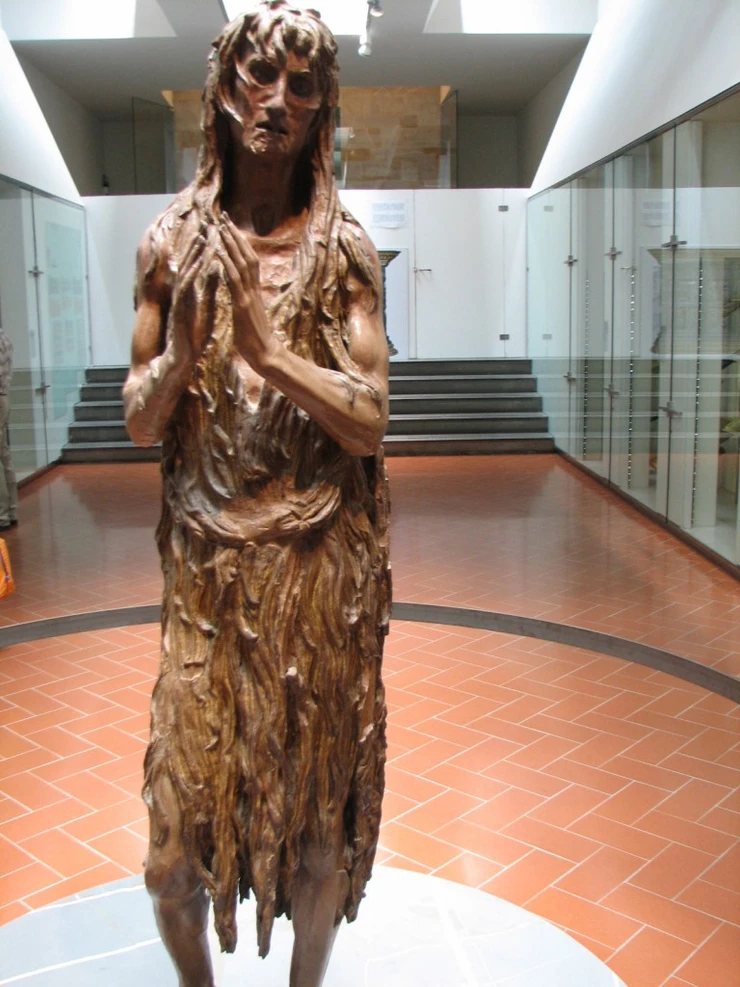
17. Penitent Mary Magdalene, 1455 | Duomo Museum, Florence
Donatello’s Penitent Magdalene is a life size wooden carving of Mary Magdalene. It stands isolated in a well lit glass case, and is very moving. It was originally commissioned for the Baptistery in Florence, but is now in the Duomo Museum.
Donatello completed this sculpture near the end of his life when he was more pious. It was his only sculpture in wood and an example of unprecedented realism.
Traditional imagery of Mary Magdalene shows her as a beautiful young woman. Donatello uses an entirely different approach. He shows her as an image of fear and decay.
She’s frail and wrinkled, after years of seclusion and penitence. With sunken eyes, Mary appears emaciated, hunched, and wrapped in her body length hair.
She’s wasted away as a hermit, seeming to be driven only by pure spiritual energy. Brought together, her long elegant hands almost form a cathedral-like shape.
The sculpture evokes a feeling of piety and atonement. Once, the statue had been painted and gilded. Much of that is gone now.
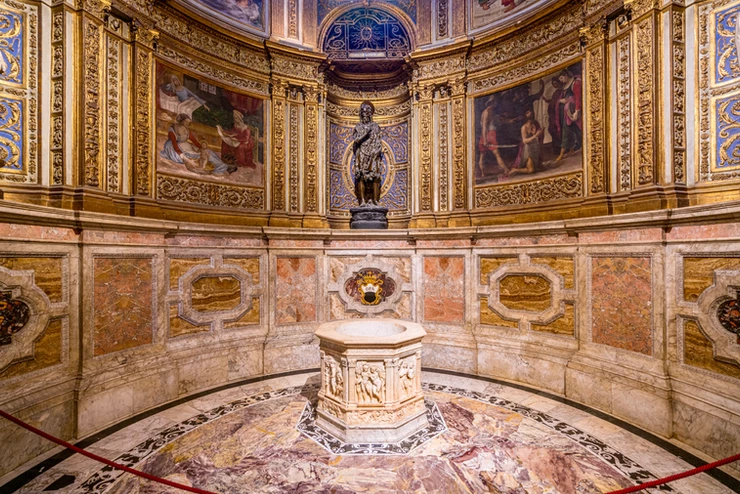
18. St. John the Baptist, 1457 | Siena Cathedral, Siena
Siena Cathedral owns Donatello’s bronze St. John the Baptist. It’s located in the Chapel of St. John the Baptist in the north transept, which also sports Pinturicchio frescos. The sculpture was relocated to Sienna after Donatello declared his wish to leave Florence and spend the rest of his life in Siena.
Clad in his usual rags, St. John the Baptist appears in agony, with a haggard face and sunken eyes. The sculpture has a funny backstory. It arrived in Siena without a right forearm. Legend holds that Donatello may have left it incomplete when he wasn’t paid in full. Or, it might have broken off in transit.
The chapel allegedly holds a relic, the arm of St. John the Baptist. But so many churches claim so many bits and pieces of the popular saint, it’s probably not there.
There are other Donatello treasures in the cathedral. He crafted a sculpture for the Door of Forgiveness on the facade of the south transept. His Madonna del Perdono is in the cathedral museum and his sculptures decorate the baptismal font in the Baptistry.
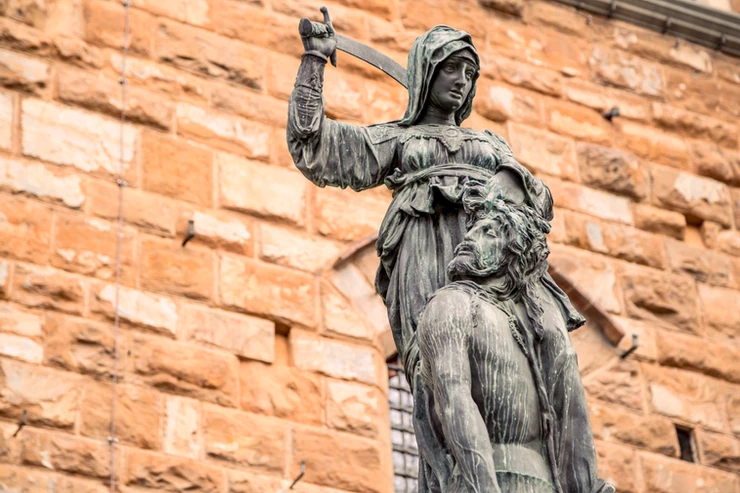
19. Judith and Holofernes, 1460 | Palazzo Vecchio, Florence
In the Hall of Lilies of Palazzo Vecchio, you’ll find another precious treasure — Donatello’s Judith and Holofernes sculpture. It’s a groundbreaking piece. Like the Bronze David, it was one of the first Renaissance sculptures to be conceived in the round.
The sculpture was commissioned by Cosimo the Elder. A copy of the sculpture is in the Piazza della Signoria for free viewing.
Judith and Holofernes is an Old Testament story, in which a heroic woman defeats a warlord who’s besieged her town in Israel. She does this by seducing, inebriating, and decapitating him.
Donatello shows a powerful Judith raising a sword with her right hand, while she holds the head of Holofernes with her left. She’s considered the symbol of liberty, virtue, and a just victory of the weak over the strong.
Judith and Holofernes carried forth the Medici’s underdog theme. The gilded statue was first placed in the garden of the Medici-Riccardi Palace. When the Medici had a short exile from the city, the citizens moved the statue into the Piazza della Signoria. The original was moved to the Hall of Lilies in 1888.
READ: Guide To the Medici Palaces in Florence
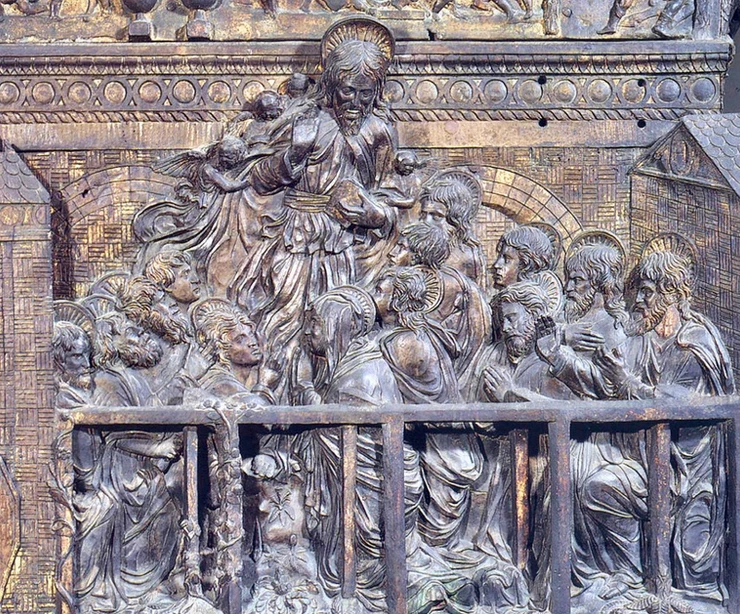
20. Pulpits in the Basilica of San Lorenzo, 1460-65, Florence
In the Basilica of San Lorenzo, Donatello created his last works, begun when he was 75. They are two bronze pulpits with intricate bas relief sculpture, the Resurrection Pulpit and the Passion Pulpit.
The latter is the most significant. Since he was too old to finish them, the pulpits were completed by his pupils Bertoldo and Bellano.
The Passion Pulpit features New Testament images of the life and passion of Christ. The reliefs are characterized by an expressionistic, occasionally violent, portrayal of the events. The next generation of sculptors criticized them.
But art historians still love them for the intensity of emotion depicted. A tragic spirituality flutters everywhere on these bas reliefs, where each figure and each scene was re-interpreted by Donatello from his study of the evangelical texts.
I hope you’ve enjoyed my guide to the masterpieces of Donatello. You may enjoy these other artist guides.
- Michelangelo Trail in Florence
- Leonardo da Vinci Trail in Milan
- Piero della Francesco Trail in Italy
- Andrea del Verrocchio’s Art in Florence
- Caravaggio Trail in Rome
- Bernini Trail in Rome
- Leonardo da Vinci’s Paintings
- Botticelli Trail in Florence
- Artemisia Gentileschi Paintings
- Raphael’s Most Famous Paintings
If you want to see Donatello’s most famous art works, pin it for later.

